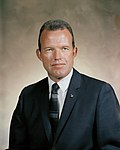The Original Seven
Forging the Path to the Stars: An exploration of the pioneering astronauts who defined the dawn of American human spaceflight.
Discover the Pioneers 👇 Meet the Crew 🧑🚀Dive in with Flashcard Learning!
🎮 Play the Wiki2Web Clarity Challenge Game🎮
Introduction
Genesis of a Mission
The Mercury Seven were the inaugural group of American astronauts, selected by NASA in 1959 for Project Mercury. This cadre of seven individuals, also known as the Original Seven or Astronaut Group 1, not only pioneered the profession of astronautics in the United States but also established the enduring image of the American astronaut for decades to come. Their selection and subsequent missions marked a critical phase in the Space Race, demonstrating American resolve and technological capability.
Defining an Era
In the crucible of the Cold War and the burgeoning Space Race, the Mercury Seven emerged as national heroes. Their missions were not merely scientific endeavors but powerful symbols of American ingenuity and courage. Each member undertook rigorous training and faced unprecedented challenges, contributing significantly to humanity's understanding of spaceflight and the human body's capacity to endure it.
A Legacy of Firsts
All seven astronauts successfully completed spaceflights, piloting missions across NASA's early human spaceflight programs: Mercury, Gemini, Apollo, and the Space Shuttle. Their individual achievements, from Alan Shepard's first American suborbital flight to John Glenn's orbital journey and later return to space, laid the groundwork for future space exploration and inspired generations.
Selection and Training
Rigorous Criteria
The selection process for the Mercury Seven was exceptionally stringent, designed to identify individuals with peak physical, mental, and professional capabilities. Candidates had to be military test pilots, under 40 years old, less than 5 feet 11 inches tall (due to spacecraft constraints), possess a bachelor's degree, have at least 1,500 flight hours, and be qualified jet pilots. These criteria aimed to ensure candidates possessed the necessary skills, resilience, and adaptability for the hazardous undertaking of spaceflight.
The Gauntlet of Tests
The selection involved a multi-stage process, beginning with the review of 508 military test pilots. Candidates underwent extensive physical examinations, psychological evaluations, and aptitude tests, including the Miller Analogies Test and various engineering and mathematical assessments. The process was designed to be exhaustive, pushing candidates to their limits to identify those with the highest potential for success and survival in the demanding environment of space.
Physical and Mental Fortitude
The astronauts endured grueling tests, including prolonged periods on treadmills and tilt tables, exposure to extreme temperatures, and various medical procedures. These trials were crucial for assessing their physiological responses and psychological resilience under stress. Despite the intensity, the candidates demonstrated remarkable fortitude, with only seven ultimately being chosen from a highly competitive pool.
The Mercury Seven
Crew Roster and Biographies
The seven astronauts selected for Project Mercury were distinguished military test pilots who would become household names. Their diverse backgrounds and unique experiences contributed to their collective success and the iconic status they achieved.
Impact and Legacy
Shaping the Astronaut Image
The Mercury Seven became cultural icons, embodying the spirit of adventure and scientific progress. Their public image, carefully managed by NASA, projected an ideal of the competent, family-oriented American hero. Their style, often characterized by short-sleeved shirts and aviator sunglasses, became synonymous with the astronaut persona. Their participation in media, notably the book "We Seven," brought the realities of space exploration to the public.
"The Right Stuff"
The story of the Mercury Seven's selection, training, and early missions was immortalized in Tom Wolfe's seminal 1979 book, "The Right Stuff." The work captured the intense pressure, the gallows humor, and the sheer bravery of these test pilots transitioning into the new frontier of space. The book was later adapted into a critically acclaimed film, further cementing the Mercury Seven's place in popular culture and history.
Inspiring Future Generations
Beyond their direct contributions to spaceflight, the Mercury Seven established the Mercury Seven Foundation in 1984, later renamed the Astronaut Scholarship Foundation. This organization provides scholarships to outstanding students pursuing degrees in science and engineering, ensuring their legacy continues to foster innovation and support future pioneers in STEM fields.
Teacher's Corner
Edit and Print this course in the Wiki2Web Teacher Studio

Click here to open the "Mercury Seven" Wiki2Web Studio curriculum kit
Use the free Wiki2web Studio to generate printable flashcards, worksheets, exams, and export your materials as a web page or an interactive game.
True or False?
Test Your Knowledge!
Gamer's Corner
Are you ready for the Wiki2Web Clarity Challenge?

Unlock the mystery image and prove your knowledge by earning trophies. This simple game is addictively fun and is a great way to learn!
Play now
References
References
- Swenson, Grimwood & Alexander 1966, pp. 28â29, 37.
- Swenson, Grimwood & Alexander 1966, pp. 69â74.
- Swenson, Grimwood & Alexander 1966, pp. 91â93.
- Swenson, Grimwood & Alexander 1966, pp. 131â132.
- Swenson, Grimwood & Alexander 1966, pp. 352â358.
- Swenson, Grimwood & Alexander 1966, pp. 494â503.
- Swenson, Grimwood & Alexander 1966, pp. 365â370.
- Swenson, Grimwood & Alexander 1966, pp. 235â237.
Feedback & Support
To report an issue with this page, or to find out ways to support the mission, please click here.
Disclaimer
Important Notice
This page was generated by an Artificial Intelligence and is intended for informational and educational purposes only. The content is based on a snapshot of publicly available data from Wikipedia and may not be entirely accurate, complete, or up-to-date.
This is not professional advice. The information provided on this website is not a substitute for professional historical, scientific, or engineering consultation. Always refer to official documentation and consult with qualified professionals for specific needs.
The creators of this page are not responsible for any errors or omissions, or for any actions taken based on the information provided herein.






